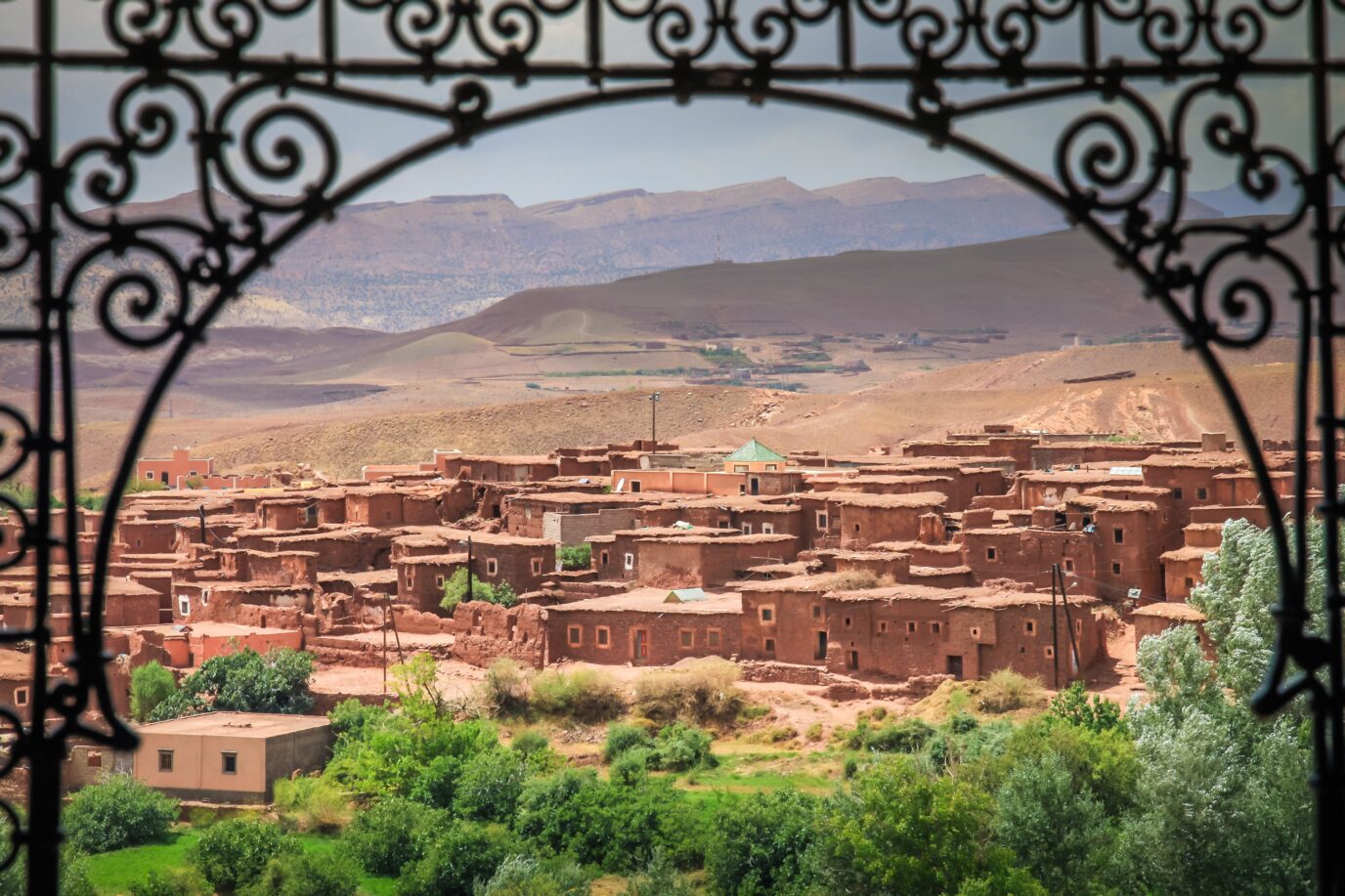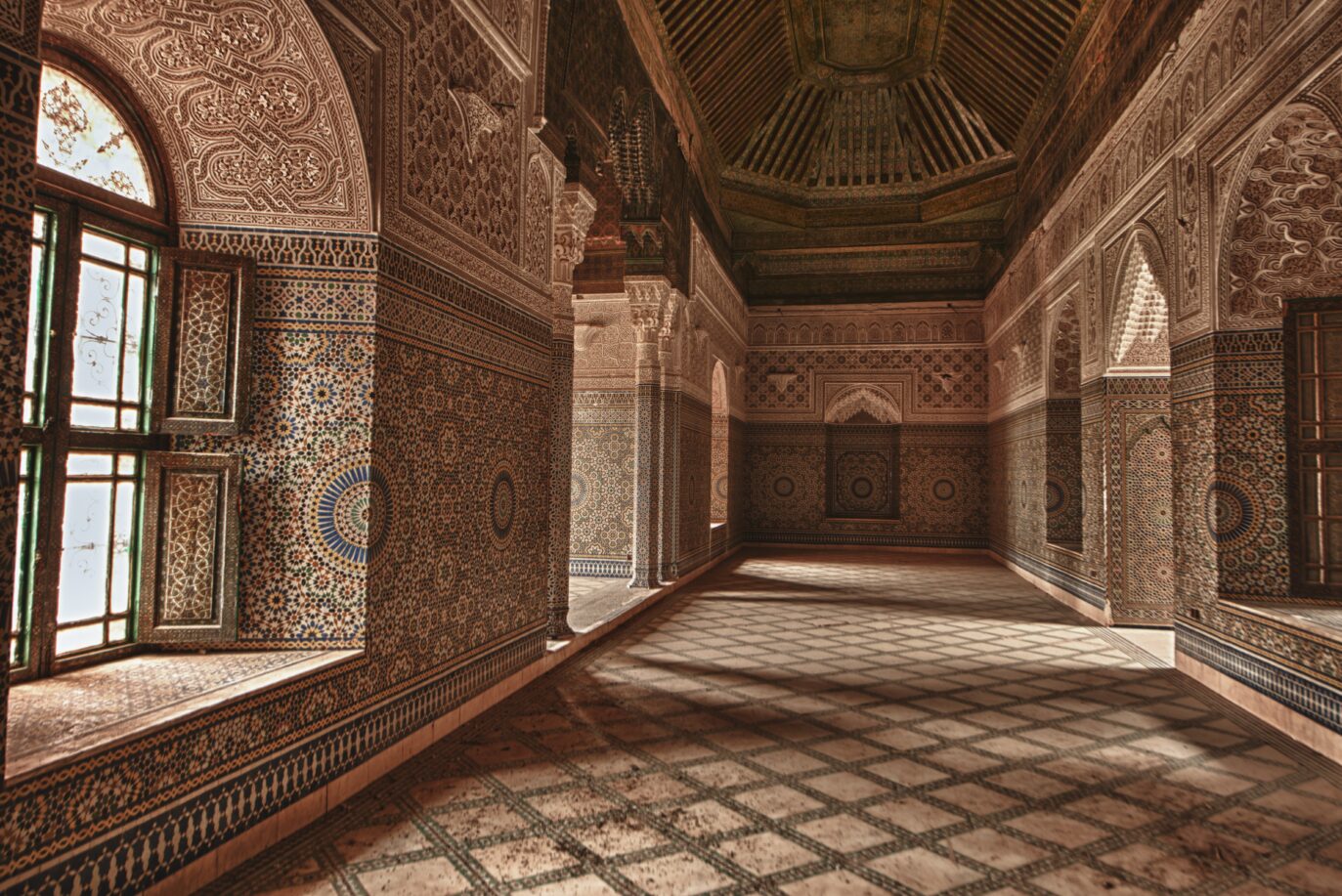Telouet Kasbah is located amidst a group of mountains with snowy peaks, valleys, and plateaus. It is the ancestral territory of the Glaoua, the former caïds who once ruled over the entire southern region and were known as the ‘lords of the Atlas.
Telouet Kasbah
Telouet houses their home, a splendid casbah built in the 19th century. A citadel symbol of strength and prestige brings together a stately residence and a military command post to control the caravan trail and the entire region.
Telouet Kasbah formed an impressive ensemble: fortress, castle, and caravanserai. This fascinating gem combines typical Amazigh architecture with a more oriental, Hispano-Moorish style, which testifies to the image of grandeur that the old masters wanted to display in front of the world. The beautifully decorated walls and the ceilings adorned with rich designs and patterns show the luxury in which the Glaoua lived, owners of the abandoned Kasbah since 1956.
The Telouet Kasbah is now succumbing to the vagaries of the weather and oblivion. Only the main house and a few outbuildings are left, and they’re still pretty well-preserved. They show visitors how skilled the artisans were, how elegant the old masters were, and how the people who lived there lived.
Why Visit Telouet Kasbah?
Hidden in the Atlas Mountains is Telouet Kasbah, a beautiful building that shows Morocco’s past and culture. The Kasbah has beautifully painted ceilings, elaborate zellij tiles, and hardwood floors that were once the main home of the powerful Glaoui family. This building is mostly destroyed, but its historical value and charm remain. Many people interested in history and culture should go to Telouet to explore the maze-like passageways, take in the stunning views of the mountains, and learn about the kasbah’s role in Morocco’s past.
Top Attractions in Telouet Kasbah
Visiting the Telouet Kasbah provides insight into the rich history and architecture of the region. Here are some of the things you might see and experience at the Kasbah of Telouet:
Historical architecture
The kasbah is known for its impressive and intricate architecture. You will find a combination of traditional Moroccan design elements, including geometric patterns, arches, and decorative tiles.
Gardens and courtyards
Like many traditional Moroccan kasbahs, Telouet boasts beautiful gardens and courtyards. These spaces often include fountains, greenery, and relaxation areas.
Residential quarters
The kasbah served as the residence of the Glaoui family, once powerful in the region. You may have the opportunity to explore different rooms and living quarters, giving you a glimpse into the lifestyle of the Glaoui family.
Decorative details
The kasbah is adorned with intricate details, including hand-carved wooden elements, stucco, and colorful tiles. Pay attention to the craftsmanship required to create these decorative elements.
Panoramic views
The Kasbah is situated in a picturesque location in the High Atlas Mountains. During your exploration, you can enjoy panoramic views of the surrounding landscapes and valleys.
Cultural heritage
The kasbah is an important part of the region’s cultural heritage. You can learn more about the history of the Glaoui family, their influence, and the role of the kasbah in local history.
Photography opportunities
The unique architecture and scenic setting make the Kasbah of Telouet an ideal photography spot. Capture the details of the kasbah itself and the breathtaking views from its vantage point.
Things to Do in Telouet Kasbah
Explore the Kasbah
Moroccan artists were very creative when they decorated the rooms in Telouet Kasbah with beautiful tilework, carved wood, and painted ceilings.
Enjoy Beautiful Mountain Views
The Kasbah’s hills have beautiful views of the nearby valleys and the Atlas Mountains. Take a break and take some pictures here.
Discover the Berber Culture
By visiting villages nearby, you can enjoy the warm hospitality of the Berber people, learn about their customs, and try real Moroccan food.
Where to Stay in Telouet Kasbah
There are a few cute guesthouses and small hotels in Telouet where people can stay comfortably. Many of these places to stay offer a traditional Moroccan experience and have beautiful views of the Atlas Mountains. Many people stay in local guesthouses or inns, where they can experience Berber hospitality and traditional meals and become part of the town’s culture. Some places to stay are close to the kasbah, making visiting the historic spot easy.
Best Time to Visit Telouet Kasbah
We suggest visiting Telouet Kasbah in the spring (March to May) or fall (September to November). The weather is nice and mild during these times, so it’s a great time to explore the kasbah and the nearby areas. Winters can be very cold, especially in the Atlas Mountains, and summers can get very hot, especially in the afternoons. A more enjoyable and relaxed visit is possible in the spring and fall when the weather is nice and fewer people are there.
How to Get to Telouet Kasbah
You can drive from Marrakech, about 100 km away, to Telouet Kasbah. You can either take a car or hire a private driver. The drive takes about two to three hours and goes through beautiful scenery, such as the High Atlas Mountains. To get to the town of Taddert, you can take the N9 road from Marrakech. Continue on that road and follow the signs to Telouet. Take a bus or shared taxi to Taddert if you’d rather take public transportation. Then, call a local cab to get to the Kasbah. Going to Telouet on the road is rough, so a 4×4 is suggested for a smoother trip.
Frequently Asked Questions
Where is the Telouet Kasbah located?
The Telouet Kasbah or Glaoui Palace is situated in the Telouet Valley, in the mountains of the Moroccan High Atlas. More precisely, it is located in the village of Telouet, which is part of the province of Ouarzazate. The kasbah is known for its historical and cultural significance and was once the residence of the Glaoui family, powerful during the French colonial period in Morocco. Today, the Kasbah of Telouet is a popular tourist attraction, drawing visitors with its intricate architecture and historical charm.




